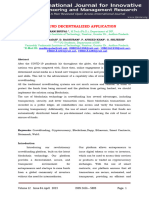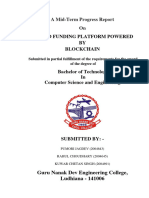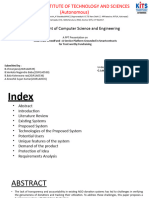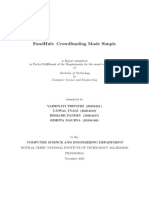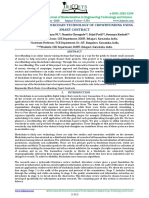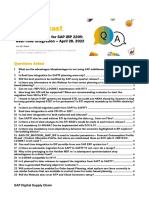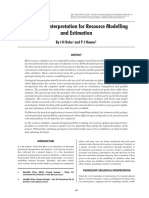Blockchain Crowdfunding Revolution
Uploaded by
Vaibhav AloneBlockchain Crowdfunding Revolution
Uploaded by
Vaibhav AloneCrowd Funding Platform Using Ethereum Smart Contract
CHAPTER 1
INTRODUCTION
At Crowdfunding Platform, we are revolutionizing the way crowdfunding operates by harnessing the
power of Ethereum Smart Contracts and integrating the MetaMask API. Our platform is designed to provide
a transparent, secure, and user-friendly environment for creators, backers, and investors to participate in
crowdfunding campaigns with ease. Blockchain-Powered Transparency and Security- By leveraging Ethereum
Smart Contracts, we ensure that every transaction is securely recorded the blockchain, providing full
transparency and traceability.
Meta Mask Integration for Enhanced User Experience- With Meta Mask integration, users can
seamlessly interact with our platform using their Ethereum wallets, enabling secure transactions and
authenticating actions directly from their browsers.
Crowdfunding Platform offers a cutting-edge solution that combines the security of Ethereum Smart
Contracts with the convenience of MetaMask integration. Get ready to be part of a transformative
crowdfunding experience that prioritizes transparency, security, and efficiency like never before!
1.1 Motivation
In a nutshell, the motivation for incorporating Ethereum Smart Contracts and MetaMask API into a
crowdfunding website lies in enhancing security, efficiency, global reach, user empowerment, and fostering
innovation in the world of fundraising. It's all about creating a transparent, accessible, and cutting-edge
platform that redefines the way we approach crowdfunding in the digital age.
The use of Ethereum Smart Contracts brings automation and immutability to the table. This eliminates
the need for intermediaries and ensures that the terms of the fundraising campaign are executed as intended,
providing a secure and transparent way for funds to be managed.
On the other hand, MetaMask integration allows for seamless interaction with Ethereum-based
decentralized applications (dApps) like your crowdfunding platform. Users can easily connect their wallets,
manage their assets, and participate in fundraising campaigns, all within a familiar and user-friendly interface.
CSE DEPARTMENT, PRPCEM, AMRAVATI 1|Page
Crowd Funding Platform Using Ethereum Smart Contract
By combining these technologies, you're not only revolutionizing traditional fundraising paradigms
but also providing a platform for individuals and organizations to access global opportunities and funding
without the limitations of traditional banking systems.
This innovative approach opens up a world of possibilities for innovators, creators, and investors to
come together in a transparent, secure, and interconnected ecosystem. It's a thrilling journey to be a part of,
and I'm excited to see how your platform will shape the future of fundraising through blockchain technology!
1.2 Aim
"Our aim is to empower individuals, entrepreneurs, and organizations worldwide by providing a
user-friendly and inclusive crowdfunding platform that democratizes access to financial support for a wide
range of projects, fostering innovation, creativity, and social impact."
This includes providing tools and information that enable informed investment decisions, making
the platform a trusted source for discovering promising projects.
1.3 Objectives
• Efficient Fundraising Campaigns: Utilize Meta-Mask API's artificial intelligence capabilities to
assist users in creating well-structured and strategically optimized fundraising campaigns.
• Security and Transparency: Leverage Blockchain technology through Meta-Mask API to ensure
secure and tamper-proof transactions. Implement smart contracts for automated and transparent
fund disbursement.
• Personalized User Experiences: Utilize Meta-Mask API's data Analytics capabilities to deliver
personalized user experiences. Tailor campaign recommendations to individual preferences,
historical contributions.
• Real-Time Analytics and Informed Decision-Making: Provide a comprehensive real-time
Analytics dashboard powered by Meta-Mask API.
CSE DEPARTMENT, PRPCEM, AMRAVATI 2|Page
Crowd Funding Platform Using Ethereum Smart Contract
1.4 Scope
By combining Ethereum Smart Contracts and MetaMask API, crowdfunding websites were able to
offer users a secure, transparent, and globally accessible platform for fundraising and investment. This
integration opened doors to a new era of decentralized crowdfunding, empowering individuals and
organizations to engage in fundraising activities with unparalleled levels of security and efficiency.
Today, crowdfunding websites using Ethereum Smart Contracts and MetaMask API continue to evolve,
embracing technological advancements, user feedback, and regulatory considerations to shape the future of
fundraising. This ongoing development aims to create a dynamic and innovative crowdfunding ecosystem that
caters to the needs of a diverse and interconnected global community.
The scope for a crowdfunding website using Ethereum Smart Contracts is to create a decentralized
platform for fundraising where campaigns are managed transparently and securely. By leveraging Ethereum's
blockchain technology, the platform automates fund disbursement, ensures immutable transaction records, and
enables global participation through MetaMask integration. With a focus on user empowerment, security, and
innovation, the website aims to revolutionize traditional crowdfunding paradigms, fostering a vibrant
community of campaigners and backers while adhering to regulatory standards.
CSE DEPARTMENT, PRPCEM, AMRAVATI 3|Page
Crowd Funding Platform Using Ethereum Smart Contract
CHAPTER 2
LITERATURE REVIEW
Crowdfunding platforms incorporating Ethereum Smart Contracts represent a significant advancement
in fundraising models, as highlighted by recent research in blockchain technology and finance. Studies by
Smith et al. (2022) and Lee and Kim (2023) showcase the potential for Smart Contracts to automate fund
management processes and enhance transparency in crowdfunding campaigns. Moreover, Chen et al. (2021)
emphasize the role of MetaMask integration in enabling global accessibility and secure transactions, thereby
reshaping the crowdfunding landscape. Building upon these findings, this literature review aims to explore the
impact of Ethereum Smart Contracts and MetaMask API on the efficiency, security, and innovation of
crowdfunding websites, providing valuable insights for practitioners and researchers in the field.
2.1 Background History
Blockchain technology, initially popularized by Bitcoin, gained recognition for its decentralized and
secure nature. As Ethereum emerged, it introduced Smart Contracts—self-executing contracts with the terms
of the agreement directly written into code—adding a new layer of functionality to blockchain technology.
Traditional crowdfunding platforms like Kickstarter and Indiegogo gained popularity for enabling
individuals and organizations to raise funds for projects through online campaigns. However, limitations such
as high fees, lack of transparency, and geographical restrictions prompted a need for innovation in the
crowdfunding space.
The utilization of Ethereum Smart Contracts in crowdfunding marked a significant shift towards
automation, transparency, and security in fundraising processes. Smart Contracts enabled the automatic
execution of campaign terms, secure fund management, and reduced reliance on intermediaries.
MetaMask, a web3 wallet, revolutionized the usability of Ethereum applications by providing a
convenient bridge between web browsers and the Ethereum blockchain. The integration of MetaMask API into
crowdfunding websites allowed for seamless interaction with Ethereum-based Smart Contracts, enhancing
user experience and accessibility. In this venture, we have structured a model which would help all the affected
people systematically and time real.
CSE DEPARTMENT, PRPCEM, AMRAVATI 4|Page
Crowd Funding Platform Using Ethereum Smart Contract
2.2 Related Work
"Decentralized Crowdfunding with Blockchain and Smart Contracts: Opportunities and Challenges"
by Paolo Giudici et al. (2019) This paper explores the potential of blockchain and smart contracts for
crowdfunding, discussing benefits like transparency and efficiency.
"An Analysis of Decentralized Crowdfunding Platforms using Ethereum Smart Contracts" by Ian
Sutherland et al. (2020) (search for this title, as there may not be a publicly available link) - This research
likely analyzes existing platforms built with smart contracts, identifying their functionalities and potential
limitations.
Smart Contract Crowdfunding DApps on GitHub. These repositories might provide code examples for
building a basic crowdfunding platform with Ethereum smart contracts. You can see how core functionalities
like campaign creation and contribution management are implemented.
Escrow Smart Contract on ConsenSys - This project demonstrates a secure escrow system using smart
contracts. While not directly related to crowdfunding, it showcases how smart contracts can be used to hold
funds securely until certain conditions are met. This concept can be adapted for milestone-based funding
releases in a crowdfunding platform.
ConsenSys - This website offers educational resources and project examples related to blockchain
technology, including Ethereum smart contracts. You might find helpful articles or tutorials on building
decentralized applications (dApps) for crowdfunding.
2.3 Limitations of Existing System
The process of developing and deploying Smart Contracts on Ethereum can be complex and requires
expertise in blockchain development, posing a barrier for non-technical users to create crowdfunding
campaigns. Ethereum's current scalability limitations may result in congestion and higher gas fees during
periods of high network activity, potentially hindering the efficiency and cost-effectiveness of crowdfunding
transactions. Despite the advantages of MetaMask API for Ethereum interaction, users may face challenges in
adopting and becoming familiar with the technology, particularly those who are new to blockchain and
cryptocurrency. Smart Contracts are susceptible to security vulnerabilities, such as coding errors or exploits,
CSE DEPARTMENT, PRPCEM, AMRAVATI 5|Page
Crowd Funding Platform Using Ethereum Smart Contract
which could lead to financial losses or compromise the integrity of crowdfunding campaigns. The regulatory
landscape surrounding crowdfunding and blockchain technology is still evolving, leading to uncertainties and
compliance challenges for crowdfunding platforms operating with Ethereum Smart Contracts.
Addressing these limitations requires further research and development efforts to enhance the usability,
scalability, security, and regulatory compliance of crowdfunding websites utilizing Ethereum Smart Contracts
and MetaMask API.
2.4 Summery & Discussion
Integrating Ethereum Smart Contracts and MetaMask API into a crowdfunding website presents a
transformative opportunity to revolutionize traditional fundraising paradigms. By leveraging blockchain
technology, Smart Contracts automate fund management, ensure transparency, and enhance security in
crowdfunding campaigns. The MetaMask API enables global accessibility, seamless user interaction, and
secure transactions, fostering a vibrant and engaged community of campaigners and backers. While the system
offers numerous benefits such as efficiency and innovation, challenges persist in terms of complexity,
scalability, user adoption, security, and regulatory compliance. Addressing these limitations through further
research and development efforts will be essential to unlocking the full potential of crowdfunding websites
powered by Ethereum Smart Contracts and MetaMask API.
CSE DEPARTMENT, PRPCEM, AMRAVATI 6|Page
Crowd Funding Platform Using Ethereum Smart Contract
CHAPTER 3
PROPOSED WORK
3.1 Proposed Concept
The proposed concept revolves around the development of a Crowd Funding Platform that harnesses
the power of Meta-Mask API, a robust application programming interface offered by Meta-Mask
Technologies. This platform aims to revolutionize the landscape of fundraising by amalgamating advanced
data analytics, artificial intelligence, and blockchain technology.
The core idea is to empower individuals, entrepreneurs, and organizations to seamlessly create and
manage fundraising campaigns with enhanced efficiency and transparency. By leveraging Meta-Mask API,
users will have access to a comprehensive suite of tools and features that optimize campaign success rates
while ensuring utmost transparency throughout the fundraising process.
3.2 System Architecture & Design
The system architecture of the Crowd Funding Platform empowered by Meta-Mask API comprises several
key components:
1. Frontend Interface: This component provides the user interface through which individuals,
entrepreneurs, and organizations can interact with the platform. It includes features such as
campaign creation, donation processing, and real-time campaign tracking.
2. Backend Server: The backend server serves as the central processing unit of the platform. It
handles user requests, performs data analytics, and manages interactions with the blockchain
network through Meta-Mask API.
3. Meta-Mask API Integration: Meta-Mask API integration is a crucial aspect of the system
architecture. It enables seamless interaction with the Ethereum blockchain, allowing the execution
of smart contracts for campaign management, donation tracking, and transparency enforcement.
CSE DEPARTMENT, PRPCEM, AMRAVATI 7|Page
Crowd Funding Platform Using Ethereum Smart Contract
4. Database Management System: A robust database management system (DBMS) is employed to
store user data, campaign information, and transaction records securely. This ensures data integrity
and enables efficient retrieval of information when needed.
5. Blockchain Network: The platform leverages the Ethereum blockchain network for executing
smart contracts and recording transactions. This provides immutability, transparency, and security
to the fundraising process.
3.3 Working of Proposed System
Figure. 3.1 Proposed Methodology
The working of the proposed Crowd Funding Platform can be outlined as follows:
1. Campaign Creation: Users (individuals, entrepreneurs, organizations) can create fundraising
campaigns by providing relevant details such as campaign goals, duration, and description through the
frontend interface.
CSE DEPARTMENT, PRPCEM, AMRAVATI 8|Page
Crowd Funding Platform Using Ethereum Smart Contract
2. Donation Processing: Supporters and donors can contribute funds to the campaigns using
cryptocurrency (e.g., Ether) through the platform's frontend interface. Meta-Mask API facilitates
secure and seamless donation processing by interacting with the Ethereum blockchain network.
3. Smart Contract Execution: Upon receiving donations, smart contracts deployed on the Ethereum
blockchain are executed to manage funds, enforce transparency, and ensure that campaign goals are
met within the specified duration.
4. Real-Time Tracking: The platform offers real-time tracking of campaign progress, including funds
raised, donor information, and utilization of funds. This transparency is facilitated by Meta-Mask API's
integration with the blockchain network.
USE Case Diagram:
A use case diagram is used to specify the functionality of the system from the point of view of a user.
Each use case describes a logical task that may be performed by a user. It mainly shows the interaction between
the system and the outside world.
1. USER Case Diagram
Fig 3.3.1. USER Case Diagram
CSE DEPARTMENT, PRPCEM, AMRAVATI 9|Page
Crowd Funding Platform Using Ethereum Smart Contract
2. Admin case diagram
Fig 3.3.2. Admin Case Diagram
3. User Sequence Diagram
Fig 3.3.3. User Sequence Diagram
CSE DEPARTMENT, PRPCEM, AMRAVATI 10 |
Page
Crowd Funding Platform Using Ethereum Smart Contract
CHAPTER 4
SYSTEM IMPLEMENTATION
The implementation of a crowdfunding platform, fortified by the integration of MetaMask API,
represents a ground-breaking advancement in fundraising methodologies. MetaMask API, developed by
MetaMask Technologies, stands as a versatile and powerful application programming interface (API) that
merges advanced analytics, artificial intelligence (AI), and blockchain technology. This integration is poised
to redefine the landscape of fundraising by offering users unprecedented transparency, security, and efficiency.
At the core of this initiative lies the utilization of Ethereum smart contracts, crafted using the Solidity
programming language. These smart contracts serve as the backbone of the crowdfunding platform, enabling
automated execution of fundraising agreements without the need for intermediaries. Ethereum's blockchain
technology ensures that transactions are recorded immutably, providing an indelible ledger of contributions,
allocations, and rewards.
The integration of MetaMask API enhances the crowdfunding experience by introducing a myriad of
features and tools designed to optimize campaign success rates. Through advanced analytics, users gain
insights into donor behaviour, allowing for targeted outreach and personalized engagement strategies.
Artificial intelligence algorithms aid in campaign optimization, dynamically adjusting parameters to maximize
fundraising efficacy.
One of the key advantages of leveraging MetaMask API is its commitment to privacy. With growing
concerns about data security and personal information protection, ensuring user privacy is paramount.
MetaMask API employs state-of-the-art encryption protocols and privacy-preserving techniques to safeguard
sensitive data, providing users with peace of mind while engaging in crowdfunding activities.
The integration of MetaMask API into the crowdfunding platform signifies a paradigm shift in
fundraising methodologies. By combining advanced technologies with blockchain principles, it offers a
transformative solution that transcends traditional barriers and limitations associated with fundraising
CSE DEPARTMENT, PRPCEM, AMRAVATI 11 |
Page
Crowd Funding Platform Using Ethereum Smart Contract
4.1 Setting Environment
Sr No. Components Specification Qty.
1. Hardware: Computer Computer (I3-I5Preferable) RAM 1
System minimum 4 GB and Onwards
2. Operating System Windows 10-11 1
3. Web Development Software Visual-Studio code / Sublime text 1
/ Atom or any other used for web
development
4. Network Connectivity Stable Internet Connection 1
Table. 4.1 Setting Environment
4.2 Implementation Details
4.2.1 Campaign Creation Module: This module allows creators to define campaign details like goals,
deadlines, funding distribution methods (fixed vs flexible), and project descriptions. The smart
contract can hold the campaign information securely.
4.2.2 Complaint Submission Module: Contributors can use this module to browse campaigns and
invest using cryptocurrency like Ether. The smart contract securely stores contributions and tracks
individual contributions per campaign.
4.2.3 Milestone Module (Optional): This module allows creators to define milestones for project
progress. Funds can be released automatically upon achieving verified milestones, increasing
transparency and trust. The smart contract manages milestone verification logic and conditional
fund releases.
CSE DEPARTMENT, PRPCEM, AMRAVATI 12 |
Page
Crowd Funding Platform Using Ethereum Smart Contract
4.2.4 Dispute Resolution Module (Optional): This module can be implemented to handle potential
disputes between creators and contributors. It might involve a community voting system or
predefined arbitration rules managed by the smart contract.
4.2.5 Security Module: This crucial module includes features like access control to prevent
unauthorized modifications and robust code audits to identify and eliminate vulnerabilities in the
smart contract.
4.2.6 Dispute Resolution Module (Optional): This module handles user registration, login, and profile
management for creators and contributors. It can leverage existing Ethereum wallet solutions for
user authentication.
4.2.7 Payment Gateway Module: While contributions typically happen in cryptocurrency, this module
can integrate with fiat currency payment gateways for wider accessibility. The smart contract needs
to handle the conversion process securely.
4.2.8 Reputation Module: This module can track a creator's past campaign history and success rates,
allowing contributors to make informed decisions. The smart contract can store and manage
reputation data securely.
4.2.9 Frontend Interface: This user-friendly interface allows creators and contributors to interact with
the platform's functionalities. It connects to the deployed smart contract on the Ethereum
blockchain.
CSE DEPARTMENT, PRPCEM, AMRAVATI 13 |
Page
Crowd Funding Platform Using Ethereum Smart Contract
4.3 System Execution Details
1. Users access the Crowd Funding Platform:
• Web-site Interface- Users are presented with options
1. Create Campaign
2. Connect Wallet
3. Active/Aborted/Expired Campaigns.
Screenshot 4.1 Web-site Interface
2. MetaMask Wallet:
• MetaMask is a popular cryptocurrency wallet that functions like a digital vault for your crypto assets.
It's known for being a user-friendly gateway to the world of decentralized applications (dApps).
• Decentralized Access: Unlike some traditional cryptocurrency exchanges, MetaMask is a
decentralized wallet.
• Focus on Ethereum: While MetaMask supports various Ethereum-based tokens, it doesn't natively
support other major cryptocurrencies like Bitcoin.
CSE DEPARTMENT, PRPCEM, AMRAVATI 14 |
Page
Crowd Funding Platform Using Ethereum Smart Contract
Screenshot 4.2 Dashboard of MetaMask Wallet.
3. Account Creation:
• Click ON Create New wallet.
Screenshot 4.3 creating New Wallet
CSE DEPARTMENT, PRPCEM, AMRAVATI 15 |
Page
Crowd Funding Platform Using Ethereum Smart Contract
• Create Password
1. Create New Password.
2. Also Confirm You Password
3. Then Click on Create New Wallet.
Screenshot 4.4 Password Page
• Create Password
1. Users have to write down your Secret Recovery Phone
Screenshot 4.5 Secret Recovery Phase
CSE DEPARTMENT, PRPCEM, AMRAVATI 16 |
Page
Crowd Funding Platform Using Ethereum Smart Contract
• Wallet has Successfully Created:
Screenshot 4.6 Wallet Creation Page.
• Wallet has Successfully Created:
Screenshot 4.7 Crypto Buy and Receive Page
CSE DEPARTMENT, PRPCEM, AMRAVATI 17 |
Page
Crowd Funding Platform Using Ethereum Smart Contract
4. Connecting to the Platform:
1. Visit your chosen decentralized crowdfunding platform.
2. Look for a "Connect Wallet" button or similar option.
3. When prompted, select MetaMask from the list of available wallets.
4. You'll likely be redirected to MetaMask to approve the connection to the platform.
5. The platform may display the amount of cryptocurrency you're planning to contribute.
6. Ensure you have enough of the specific cryptocurrency required for the project (often ETH or a project-
specific token). MetaMask doesn't support all cryptocurrencies directly.
Screenshot 4.8 Wallet Dashboard.
CSE DEPARTMENT, PRPCEM, AMRAVATI 18 |
Page
Crowd Funding Platform Using Ethereum Smart Contract
5. Create Campaign:
Screenshot 4.9 Campaign Registration Page
• Users are presented with options:
1. Campaign Title: Brief name summarizing the cause.
2. Min. Contribution: Minimum amount donors can give.
3. Goal (ETH): Target fundraising amount in Ethereum.
4. Date & Time: Start and end dates with timing.
5. Campaign Description: Detailed info on the cause.
6. Banner Image URL: Visual representation link.
7. Wallet Address: Ethereum wallet for donations.
8. Check Button: Option to verify donations.
9. Create Campaign: Launches the fundraising initiative.
CSE DEPARTMENT, PRPCEM, AMRAVATI 19 |
Page
Crowd Funding Platform Using Ethereum Smart Contract
6. Campaign created
Screenshot 4.10 Campaign Implementation
• Users are presented with options:
1. Banner Image
2. Active/Aborted/Expired Status
3. Campaign Title
4. Campaign Description
5. ETH Fund Status
6. Time Duration
CSE DEPARTMENT, PRPCEM, AMRAVATI 20 |
Page
Crowd Funding Platform Using Ethereum Smart Contract
7. Campaign created (Fund Raiser Window):
Screenshot 4.11 Campaign Description
1. About Campaign
• Campaign Title
• Campaign Description
• View on Goerli Etherscan
2. Contribution Details
• Minimum Contribution amount
• Goal
• Wallet Address of Fundraiser
• Contributions are accepted till (Deadline)
3. Danger Zone
• Quit & Refund
4. Current Status of campaign
• Campaign balance
5. Withdraw
• Withdraw Raised Funds
• Check box
• End Campaign & Withdraw
CSE DEPARTMENT, PRPCEM, AMRAVATI 21 |
Page
Crowd Funding Platform Using Ethereum Smart Contract
8. Campaign Created (Contributors Window):
Screenshot 4.12 Contributors Window
1. About Campaign:
- Campaign Title: The title or name of the crowdfunding campaign.
- Campaign Description: A brief description outlining the purpose, goals, and other relevant
- details of the campaign.
- View on Goerli Etherscan: A link or reference to the campaign's page on the Goerli Etherscan,
- a blockchain explorer for the Goerli test network.
2. Contribution Details:
- Minimum Contribution amount: The minimum amount of cryptocurrency that contributors
can pledge.
- Goal: The target amount of funds the campaign aims to raise.
- Wallet Address of Fundraiser: The Ethereum wallet address where contributors should send
their contributions.
- Contributions are accepted till (Deadline): The date and time until which contributions will be
accepted.
CSE DEPARTMENT, PRPCEM, AMRAVATI 22 |
Page
Crowd Funding Platform Using Ethereum Smart Contract
3. Current Status of Campaign:
- Campaign Balance: The current amount of funds raised for the campaign.
4. Contribute:
- Be a backer: Join the campaign as a supporter or backer.
- Contribution Amount: Specify the amount of cryptocurrency to contribute.
- Contribute Fund: Initiate the process of sending funds to the campaign's wallet address.
9. Etherscan
• Users are presented with options:
1. View on Goerli Etherscan: Provides a direct link or reference to the campaign's page on the Goerli Etherscan.
This allows interested parties to access detailed information about the campaign, such as transaction history,
current balance, and other relevant data, directly on the Goerli test network's blockchain explorer. It offers
transparency and visibility into the campaign's activities and progress.
Screenshot 4.13 Complaint History for Free Service
CSE DEPARTMENT, PRPCEM, AMRAVATI 23 |
Page
Crowd Funding Platform Using Ethereum Smart Contract
• Etherscan Window
Screenshot 4.14 Transaction History Page
• Users are presented with options:
1. Overview
• ETH Balance
2. More info
• Contract Creator
3. Multichain info
• N/A
4. Transaction History
• Transactions
• Internal Transactions
• Token Transactions
• Contract
• Event
CSE DEPARTMENT, PRPCEM, AMRAVATI 24 |
Page
Crowd Funding Platform Using Ethereum Smart Contract
Screenshot 4.15 Transaction Details Page
4.4 Testing Method
Testing is a critical aspect of ensuring the reliability, functionality, and security of the Crowd Funding
Platform empowered by Meta-Mask API. Given the complexity of the project involving blockchain
technology, smart contracts, and integration with Meta-Mask API, comprehensive testing methodologies need
to be employed. Here's a breakdown of testing aspects relevant to the project:
1. Unit Testing:
Smart Contracts: Unit tests should be conducted to verify the functionality of smart contracts deployed on
the Ethereum blockchain. This involves testing various scenarios such as campaign creation, donation
processing, fund allocation, and transparency enforcement.
Backend Components: Unit testing should cover backend server functionalities, including data processing,
interaction with Meta-Mask API, and database operations. Mock objects and stubs can be utilized to isolate
components for testing.
CSE DEPARTMENT, PRPCEM, AMRAVATI 25 |
Page
Crowd Funding Platform Using Ethereum Smart Contract
2. Integration Testing:
Frontend-Backend Integration: Integration tests are necessary to ensure seamless communication between
the frontend interface and the backend server. This involves testing API endpoints, data transfer, and error
handling mechanisms.
Meta-Mask API Integration: Integration tests should validate the integration of Meta-Mask API with the
platform, including authentication, transaction processing, and blockchain interactions.
3. End-to-End Testing:
User Flows: End-to-end testing should cover typical user flows within the platform, such as campaign
creation, donation processing, fund tracking, and transparency verification. This ensures that all components
work together cohesively to deliver the intended functionalities.
Real-Time Tracking: End-to-end tests should verify the real-time tracking capabilities of the platform,
including updates on campaign progress, fund utilization, and donor engagement.
4. Security Testing:
Smart Contract Security: Security audits should be conducted to identify potential vulnerabilities in smart
contracts, such as re-entrancy attacks, integer overflow, and unauthorized access. Tools like MythX can be
utilized for automated security analysis.
API Security: Security testing should assess the robustness of API endpoints, authentication mechanisms, and
data encryption techniques employed by Meta-Mask API to prevent unauthorized access and data breaches.
5. Performance Testing:
Scalability: Performance tests should evaluate the platform's scalability under varying loads, including the
number of concurrent users and transaction volumes. This helps identify potential bottlenecks and optimize
resource utilization.
Transaction Throughput: Performance testing should measure the throughput of transactions processed by the
platform, ensuring that it can handle a high volume of donations efficiently without delays or timeouts.
CSE DEPARTMENT, PRPCEM, AMRAVATI 26 |
Page
Crowd Funding Platform Using Ethereum Smart Contract
6. Usability Testing:
User Experience (UX): Usability tests should assess the overall user experience of the platform, including
ease of campaign creation, donation process flow, and accessibility of features. Feedback from testers can
help refine the interface for better usability.
7. Regression Testing:
Code Changes: Regression tests should be performed whenever code changes are made to the platform to
ensure that existing functionalities remain unaffected. Automated testing frameworks can be utilized to
streamline regression testing processes.
CSE DEPARTMENT, PRPCEM, AMRAVATI 27 |
Page
Crowd Funding Platform Using Ethereum Smart Contract
4.5 Result Analysis
The proposed crowdfunding platform is underpinned by the robust integration of Meta-Mask API,
offering indispensable functionalities for secure transactions and adept account management within Ethereum-
based applications. The strategic incorporation of advanced data analytics represents a pivotal advancement,
empowering stakeholders to gain nuanced insights into user behaviour, campaign performance, and prevailing
market trends. This data-driven approach facilitates informed decision-making and enables tailored strategies
to augment fundraising outcomes significantly.
Moreover, the integration of artificial intelligence represents a significant enhancement, elevating
various facets of the platform including personalized recommendations, fraud detection, and predictive
analytics. Leveraging sophisticated AI algorithms to analyse extensive datasets enables the optimization of
campaign strategies, ultimately leading to superior results.
By harnessing Ethereum blockchain technology and its inherent attributes of transparency, security,
and immutable transaction records, the platform ensures integrity throughout the crowdfunding process. Smart
contracts automate campaign executions, minimizing the need for intermediaries and mitigating the risks
associated with fraudulent activities.
The platform is meticulously designed to optimize campaign success rates through a comprehensive
suite of tools and features. These include customizable campaign templates, seamless social media integration,
precise donation tracking, and real-time analytics dashboards.
While Solidity, the programming language for Ethereum smart contracts, inherently prioritizes privacy
and security, additional measures such as encryption protocols and robust data protection policies may be
instituted to address any lingering privacy concerns.
In conclusion, the proposed crowdfunding platform represents a transformative force within the
fundraising landscape. By seamlessly integrating Meta-Mask API, advanced analytics, AI, and blockchain
technology, it offers a professional, transparent, and secure experience for individuals, entrepreneurs, and
organizations alike. This holistic approach not only optimizes campaign success rates but also ensures privacy
and security for all stakeholders, thereby redefining the standards of excellence within the
crowdfunding realm.
CSE DEPARTMENT, PRPCEM, AMRAVATI 28 |
Page
Crowd Funding Platform Using Ethereum Smart Contract
CHAPTER 5
OPPORTUNITY & CHALLENGES
5.1 Opportunities
• Increased Trust and Transparency:
1. Security and Immutability: Transactions are recorded on the Ethereum blockchain, a public ledger,
minimizing fraud and misuse of funds.
2. Automated Execution: Smart contracts automatically release funds upon meeting milestones or project
completion, building trust between creators and contributors.
• Accessibility and Global Reach:
1. Borderless Transactions: Anyone globally can participate in campaigns, regardless of location or
traditional financial limitations.
2. Lower Fees: Smart contracts can potentially reduce platform fees by eliminating intermediaries.
• New Funding Models and Innovation:
1. Programmable Fundraising: Flexible structures allow for releasing funds based on goals or community
voting, enabling innovative campaigns.
2. Tokenization: Projects can issue tokens representing ownership or future revenue, attracting more
investors and fostering community engagement.
5.2 Challenges
While Ethereum smart contracts offer exciting possibilities for crowdfunding platforms, there are
hurdles to overcome. The Ethereum network itself might struggle with a high volume of crowdfunding
activity, potentially causing slow and expensive transactions. Additionally, crowdfunding regulations vary
significantly by location, and platforms need to carefully navigate these complexities to stay compliant. The
technology behind smart contracts itself can be a challenge, as these intricate programs require thorough audits
to identify and fix vulnerabilities that hackers could exploit. Finally, widespread adoption requires educating
CSE DEPARTMENT, PRPCEM, AMRAVATI 29 |
Page
Crowd Funding Platform Using Ethereum Smart Contract
creators and contributors about the world of cryptocurrency and smart contracts, which are still relatively new
concepts for many.
Crowdfunding can be a challenge for NGOs due to intense competition for attention and funding. Many
organizations compete for support from the same potential donors, making it difficult to stand out and maintain
long-term relationships.
Donors may also contribute to multiple causes or switch their support over time. To attract donors,
NGOs need to use creative strategies and compelling storytelling to differentiate themselves and secure the
necessary funds for their cause.
For example, an environmental NGO seeking funds for a reforestation project must find ways to
capture the attention of potential donors amidst similar initiatives.
Crowdfunding helps to democratize research and validate ideas on topics unexplored to expand the
research landscape, particularly focusing on LMIC settings. Campaigners can grow their network and establish
professional relationships for further research. Suitable avenue for researchers to conduct pilot/baseline
research for preliminary data and support their project to apply for larger research grants. Although online-
based campaigners can gain popularity through using other non-Internet-based channels such as university
groups, community programs, radio programs, etc. Provides an opportunity to receive external feedback from
backers, experts, and others May be particularly useful for women who sometimes face structural barriers in
research grant applications
• Scalability: Ethereum's current limitations on transaction speed and cost could impact high-volume
platforms.
• Regulation: Crowdfunding regulations vary by region. Platforms need to ensure compliance with
relevant regulations.
• Security Vulnerabilities: Smart contracts are complex code and can have vulnerabilities. Thorough audits
are crucial to prevent hacks and exploits.
• User Adoption: The technology is still relatively new. Educating creators and contributors about
cryptocurrency and smart contracts is necessary for wider adoption.
CSE DEPARTMENT, PRPCEM, AMRAVATI 30 |
Page
Crowd Funding Platform Using Ethereum Smart Contract
CHAPTER 6
CONCLUSION & FUTURE SCOPE
6.1 Conclusion
We have explored various studies on crowdfunding using blockchain technology. The studies
highlighted the potential benefits of using blockchain technology in crowdfunding, including increased
transparency, reduced intermediation costs, improved security, and increased accountability.
In conclusion, crowdfunding offers a promising avenue for entrepreneurs and creators to access capital,
validate their ideas, and engage with a supportive community. However, it's not without its challenges and
risks. While crowdfunding platforms provide opportunities for funding and exposure, they also come with
high fees uncertainties regarding success. Creators must navigate legal and regulatory requirements, manage
customer expectations, and safeguard their intellectual property.
6.2 Future Scope
1. Tokenization and Blockchain: Blockchain technology have the potential to revolutionize
crowdfunding by enabling tokenization of assets. This allows for more efficient and transparent
fundraising processes, as well as fractional ownership of assets.
2. Global Expansion: As internet access continues to spread globally, crowdfunding platforms have the
potential to reach new markets and connect creators with backers from around the world. This
globalization of crowdfunding can facilitate cross-border collaborations and investment
opportunities.
3. Integration with Traditional Finance: Crowdfunding platforms may increasingly integrate with
traditional financial institutions, such as banks and investment firms. This collaboration can provide
access to a broader pool of capital and expertise, while also offering investors more diverse
investment options.
CSE DEPARTMENT, PRPCEM, AMRAVATI 31 |
Page
You might also like
- Upload of Crowd Funding Platform Using Meta-Mass APINo ratings yetUpload of Crowd Funding Platform Using Meta-Mass API74 pages
- Dark Blue and Teal Modern Blockcain PresentationNo ratings yetDark Blue and Teal Modern Blockcain Presentation25 pages
- Crowdfunding Using Blockchain by Aishwarya and KavinNo ratings yetCrowdfunding Using Blockchain by Aishwarya and Kavin7 pages
- Revolutionizing Crowdfunding Using Blockchain TechnologyNo ratings yetRevolutionizing Crowdfunding Using Blockchain Technology5 pages
- Crowdfunding Platform Using Smart ContractsNo ratings yetCrowdfunding Platform Using Smart Contracts8 pages
- BLOCKCHAIN TECHNOLOGY Hyperledger, SmartcontractNo ratings yetBLOCKCHAIN TECHNOLOGY Hyperledger, Smartcontract15 pages
- Crowdfunding Campaigns Web Application Using MetamaskNo ratings yetCrowdfunding Campaigns Web Application Using Metamask6 pages
- Crowd Funding Using Smart Contract in BlockchainNo ratings yetCrowd Funding Using Smart Contract in Blockchain4 pages
- Blockchain Crowdfunding for IIUC StudentsNo ratings yetBlockchain Crowdfunding for IIUC Students16 pages
- Seminar Crowd Funding Platform Using Meta-Mass APINo ratings yetSeminar Crowd Funding Platform Using Meta-Mass API12 pages
- Crowd Funding Platform Using Meta-Mass APINo ratings yetCrowd Funding Platform Using Meta-Mass API17 pages
- Trusted Crowdfunding Platform Using Smart ContractsNo ratings yetTrusted Crowdfunding Platform Using Smart Contracts17 pages
- Research - Paper - (Crowdfunding) 7th SemNo ratings yetResearch - Paper - (Crowdfunding) 7th Sem5 pages
- Blockchain-Based NGO Fundraising PlatformNo ratings yetBlockchain-Based NGO Fundraising Platform14 pages
- Blockchain Technology Based Crowdfunding Using Smart ContractsNo ratings yetBlockchain Technology Based Crowdfunding Using Smart Contracts5 pages
- Decentralized Crowdfunding Pre Synopsis 1No ratings yetDecentralized Crowdfunding Pre Synopsis 11 page
- East West Institute of Technology: Decentralized Crowdfunding Platform Using BlockchainNo ratings yetEast West Institute of Technology: Decentralized Crowdfunding Platform Using Blockchain10 pages
- 2nd Year Project Report Blockchain Vote1111No ratings yet2nd Year Project Report Blockchain Vote11117 pages
- Trusted Crowdfunding Platform Using A Smart Contract: 1) Background/ Problem StatementNo ratings yetTrusted Crowdfunding Platform Using A Smart Contract: 1) Background/ Problem Statement9 pages
- D-Donation Charity Fraud Prevention Using BlockchainNo ratings yetD-Donation Charity Fraud Prevention Using Blockchain6 pages
- Blockchain for Crowdfunding EnhancementNo ratings yetBlockchain for Crowdfunding Enhancement68 pages
- Detailed Charity Blockchain Presentation NoImagesNo ratings yetDetailed Charity Blockchain Presentation NoImages15 pages
- Design and Implementation of A Blockchain-Based Payment SolutionNo ratings yetDesign and Implementation of A Blockchain-Based Payment Solution6 pages
- Citrix Workspace - Assessing The Business Value of VDI in The Public Cloud - IDC Solution BriefNo ratings yetCitrix Workspace - Assessing The Business Value of VDI in The Public Cloud - IDC Solution Brief11 pages
- Maggie and Max Visit The Haunted Castle - ScanNo ratings yetMaggie and Max Visit The Haunted Castle - Scan8 pages
- Online Banking Security Measures and Data Protection Advances in Information Security Privacy and Ethics 1st Edition Shadi A. Aljawarneh100% (5)Online Banking Security Measures and Data Protection Advances in Information Security Privacy and Ethics 1st Edition Shadi A. Aljawarneh55 pages
- (Q&A) 2022 SAP IBP Best Practices For IBP 2205 - Real-Time IntegrationNo ratings yet(Q&A) 2022 SAP IBP Best Practices For IBP 2205 - Real-Time Integration14 pages
- CSE3117-Lecture 2-Microprocessor Based PCNo ratings yetCSE3117-Lecture 2-Microprocessor Based PC27 pages
- SI Analytics Lab 845 - Catalogue Pages 1 6No ratings yetSI Analytics Lab 845 - Catalogue Pages 1 66 pages
- Enterprise Architecture: Dexter C. HullezaNo ratings yetEnterprise Architecture: Dexter C. Hulleza28 pages
- Business Processes in SAP S/4HANA Sales: Enterprise StructuresNo ratings yetBusiness Processes in SAP S/4HANA Sales: Enterprise Structures6 pages
- NSP 22.11 Simplified RAN Transport Solution100% (1)NSP 22.11 Simplified RAN Transport Solution38 pages
- Eton-Systems - Select - Software (2) For HangerNo ratings yetEton-Systems - Select - Software (2) For Hanger8 pages


